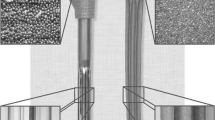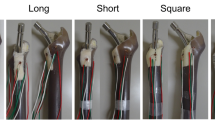Abstract
Introduction
High loosening rates after distal femoral replacement may be due to implant design not adapted to specific anatomic and biomechanical conditions.
Materials and methods
A modular tumor system (MUTARS®, Implantcast GmbH) was implanted with either a curved hexagonal or a straight tapered stems in eight Sawbones® in two consecutively generated bone defect (10 cm and 20 cm proximal to knee joint level). Implant-bone-interface micromotions were measured to analyze main fixation areas and to characterize the fixation pattern.
Results
Although areas of highest relative micromotions were measured distally in all groups, areas and lengths of main fixation differed with respect to stem design and bone defect size. Regardless of these changes, overall micromotions could only be reduced with extending bone defects in case of tapered stems.
Conclusions
The tapered design may be favorable in larger defects whereas the hexagonal may be advantageous in defects located more distally.



Similar content being viewed by others
References
Bergmann G, Bender A, Dymke J, Duda G, Damm P (2016) Standardized loads acting in hip implants. PLoS One 11:e0155612
Bergmann G, Bender A, Graichen F, Dymke J, Rohlmann A, Trepczynski A et al (2014) Standardized loads acting in knee implants. PLoS One 9:e86035
Bernthal NM, Greenberg M, Heberer K, Eckardt JJ, Fowler EG (2015) What are the functional outcomes of endoprosthestic reconstructions after tumor resection? Clin Orthop Relat Res 473:812–819
Bernthal NM, Schwartz AJ, Oakes DA, Kabo JM, Eckardt JJ (2010) How long do endoprosthetic reconstructions for proximal femoral tumors last? Clin Orthop Relat Res 468:2867–2874
Capanna R, Scoccianti G, Frenos F, Vilardi A, Beltrami G, Campanacci DA (2015) What was the survival of megaprostheses in lower limb reconstructions after tumor resections? Clin Orthop Relat Res 473:820–830
Cristofolini LVM, Cappello A, Toni A (1996) Mechanical validation of whole bone composite femur models. J Biomech 29:525–535
Engh CA, O’Connor D, Jasty M, McGovern TF, Bobyn JD, Harris WH (1992) Quantification of implant micromotion, strain shielding, and bone resorption with porous-coated anatomic medullary locking femoral prostheses. Clin Orthop Relat Res 13–29
Gortz W, Nagerl UV, Nagerl H, Thomsen M (2002) Spatial micromovements of uncemented femoral components after torsional loads. J Biomech Eng Trans ASME 124:706–713
Gosheger G, Gebert C, Ahrens H, Streitbuerger A, Winkelmann W, Hardes J (2006) Endoprosthetic reconstruction in 250 patients with sarcoma. Clin Orthop Relat Res 450:164–171
Gosheger G, Winkelmann W (2000) Mutars—a modular tumor- and revision system. Experiences at the Munster Tumor Center. Orthopade 29(Suppl 1):S54–S55
Jahnke A, Jakubowitz E, Ishaque BA, Rickert M, Bischel O (2016) Influence of cerclages on primary stability of tumor megaprostheses subjected to distal femur defects. Injury 47:453–459
Jakubowitz E, Bitsch RG, Heisel C, Lee C, Kretzer JP, Thomsen MN (2008) Primary rotational stability of cylindrical and conical revision hip stems as a function of femoral bone defects: an in vitro comparison. J Biomech 41:3078–3084
Jakubowitz E, Kinkel S, Nadorf J, Heisel C, Kretzer JP, Thomsen MN (2011) The effect of multifilaments and monofilaments on cementless femoral revision hip components: an experimental study. Clin Biomech 26:257–261
Jasty M, Bragdon C, Burke D, O’Connor D, Lowenstein J, Harris WH (1997) In vivo skeletal responses to porous-surfaced implants subjected to small induced motions. J Bone Jt Surg Am 79:707–714
Kinkel S, Graage JD, Kretzer JP, Jakubowitz E, Nadorf J (2013) Influence of stem design on the primary stability of megaprostheses of the proximal femur. Int Orthop 37:1877–1883
Kinkel S, Lehner B, Kleinhans JA, Jakubowitz E, Ewerbeck V, Heisel C (2010) Medium to long-term results after reconstruction of bone defects at the knee with tumor endoprostheses. J Surg Oncol 101:166–169
Kinkel S, Nadorf J, Graage JD, Jakubowitz E, Kretzer JP (2015) Primary rotational stability of various megaprostheses in a biomechanical sawbone model with proximal femoral defects extending to the isthmus. PLoS One 10:e0129149
Nadorf J, Klein SB, Gantz S, Jakubowitz E, Kretzer JP, Bischel OE (2017) Influence of implant length and bone defect situation on primary stability after distal femoral replacement in vitro. Knee 24:1016–1024
Nadorf J, Thomsen M, Gantz S, Sonntag R, Kretzer JP (2014) Fixation of the shorter cementless GTS stem: biomechanical comparison between a conventional and an innovative implant design. Arch Orthop Trauma Surg 134:719–726
Schmidbauer U, Brendel T, Kunze KG, Nietert M, Ecke H (1993) Dynamic force measurement in implantation of total endoprostheses of the hip joint. Unfallchirurgie 19:11–15
Funding
The implants were funded by Implantcast GmbH. The funding party had no role in study design, data collection and analysis, decision to publish or preparation of the manuscript.
Author information
Authors and Affiliations
Corresponding author
Ethics declarations
Conflict of interest
The authors declare that they have no conflict of interest. This work was performed at the Laboratory of Biomechanics and Implant Research, Department of Orthopedics and Traumatology, University Hospital Heidelberg, Heidelberg, Germany.
Ethical approval
This article does not contain any studies with human participants or animals performed by any of the authors.
Additional information
Publisher’s Note
Springer Nature remains neutral with regard to jurisdictional claims in published maps and institutional affiliations.
Rights and permissions
About this article
Cite this article
Bischel, O.E., Nadorf, J., Klein, S.B. et al. Modular tumor prostheses: are current stem designs suitable for distal femoral reconstruction? A biomechanical implant stability analysis in Sawbones. Arch Orthop Trauma Surg 139, 843–849 (2019). https://doi.org/10.1007/s00402-019-03158-y
Received:
Published:
Issue Date:
DOI: https://doi.org/10.1007/s00402-019-03158-y




